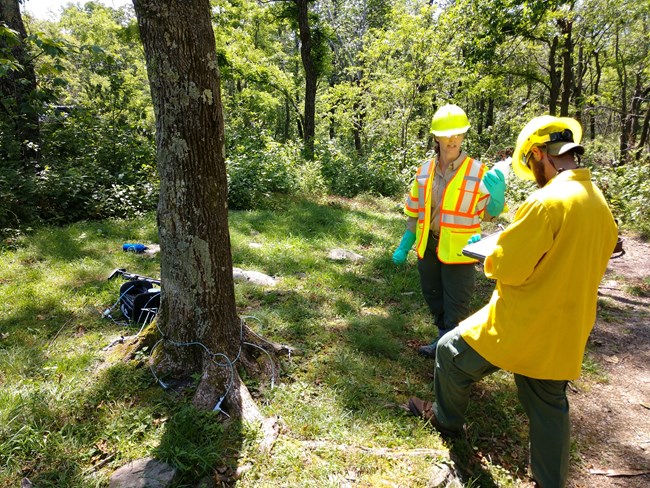Last updated: November 8, 2019
Article
Shenandoah National Park Fights Emerald Ash Borer

NPS Photo
The Emerald Ash Borer (EAB), a non-native wood boring pest, has spread rapidly through the eastern United States. EAB could be the most devastating threat to American forests since a blight decimated American chestnut tree populations in the last century.
At Shenandoah, where ash trees make up about 5% of the forest cover, EAB has already been found throughout the park. Heavy ash mortality is currently concentrated in the northern parts of the park, but is expected to expand southward over the next few years. Within three to five years of infestation, about 99% of the affected trees die. The dead ash trees degrade rapidly, causing potential hazards for visitors to the park.
Trees can be protected from EAB, however, if they are treated before EAB attacks. The protection of ash trees in park developed areas is a high priority.
In 2019 park staff, supported by a grant from the Trust, trained 10 volunteers, interns, and staff on effective EAB suppression methods. State certified training for many of the volunteers and interns takes at least 40 hours of combined manual and field time in addition to an exam. These treatments involve injecting the base of ash trees with emamectin benzoate (like a tree IV). The process is often slow and can take one to two hours, depending on the size of the tree. The treatment is expensive and sometimes tedious but provides about three years of protection. Staff must use gloves, long sleeves and eye protection when applying the pesticide. The upside of using this pesticide is that it has little effect on pollinators.
In 2019, park staff, along with cooperators from the Virginia Department of Forestry and Fairfax County Forestry, treated 343 ash trees at Loft Mountain Campground, a location where ash trees make up most of the forest. Trees are marked and mapped. The total number of trees treated exceeded expectations for what could be accomplished in a single year. Additionally, by cooperating with other agencies, the park was able to receive assistance but also learned new efficiencies by sharing information and techniques.
The park hopes to repeat this project in the future, perhaps treating an additional 200-400 trees. Shenandoah is going to focus the efforts and target ash trees around campgrounds, picnic areas, overlooks and other areas frequently used by visitors. The ongoing support by the Shenandoah National Park Trust will allow the park to continue this important work.
